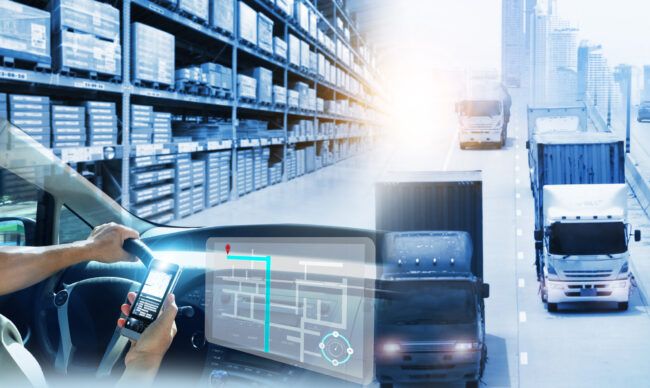
Fleet vehicle management is a job filled with many responsibilities, but fleet manager decisions are ultimately driven by efficiency. More efficient drivers get loads delivered in less time — more efficient fleet vehicles use less fuel — and efficient spending leads to a bigger bottom line or more cash flow.
Three powerful business tools help fleet managers run more efficient fleets. These tools reduce fuel costs leading to less money spent on your largest budgeted expense:
- Fleet cards (also known as fuel cards or business gas cards)
- GPS vehicle tracking
- Mobile applications
Each of these offers a host of other benefits beyond spending less on gas or diesel.
Let’s look at how fleet cards, vehicle tracking and mobile apps can help decrease fuel expenditure and operate a better fleet.
The Fleet Card Advantage
Many businesses use fleet cards to pay for gas or diesel. These fuel cards are convenient and offer multiple ways to pay less for fuel, beginning with rebates.
Fuel Rebates with a Fleet Card
The most apparent advantage of fleet cards is direct savings at the fuel pump. Though gas and diesel prices are constantly in flux, many fleet cards offer reliable savings no matter what. Fuel card rebates vary from card to card and tend to increase with more fuel purchased. The more you spend, the more you save on each gallon.
Paying less for gas or diesel is a quick and easy way to save on fuel. But a good fuel rebate is only one way a fleet card can help you save.
With a fleet card, you know which drivers spend how much and on what.
Fleet Cards Offer Spending Controls
Fleet cards typically include spending or purchase controls. This feature allows you or your fleet managers to set various purchase limits. These controls make it easy to:
- Limit when fuel transactions can be made by time of day or day of week.
- Set gallon limits based on day, week, month, vehicle or driver.
- Limit the number of purchases allowed each day.
- Approve transactions for fuel only or fuel and maintenance.
Setting spending controls does not reduce how much you spend per gallon, but they do limit transactions and prevent misuse. Both of which lead to less money spent at fueling stations.
Plus each transaction is recorded as it happens.
Real-time Data with Fleet Fuel Cards
When drivers purchase fuel or pay for maintenance, the transaction details are recorded in your fleet card dashboard. This means you have access to the data as purchases are made.
With traditional credit cards or cash, you can’t make budgetary adjustments as transactions happen. This is because you must wait for credit card statements or expense reports.
With a fleet card you don’t need to wait, you know which drivers spend how much and on what. Real-time data means you can make real-time shifts to fuel spending.
Fuel Cards Have Automated Fuel Expense Tracking
Real-time transaction information gives you much more than the data as purchases happen. Because information from fuel purchases or vehicle maintenance invoices is cataloged in your fleet card dashboard, you no longer need to worry about fuel expense reports.
Real-time transaction data equals automated fuel expense tracking — no more risk of human error or hours spent on time-consuming expense reports.
This means your accounting department can spend more time budgeting, forecasting and controlling your largest expenditure: fuel.
Fuel Purchase Reporting and Fuel Accounting with Fleet Cards
With all your fuel card data in your fleet card dashboard, you can put the information to good use. Fleet cards are equipped with some powerful reporting tools. These reports give you some incredible data analytics. Run the reports you need when you need them with accurate and up-to-date information. At the click of a button, you can run:
- Transaction reports based on time frame, driver or vehicle.
- Exception reports based on purchase limits.
- Vendor reports outlining costs by vendor.
- Excessive activity reports showing high activity in a given time frame.
- Summary reports of dollars spent by category.
- Tax reports.
- Reports based on the time frame and parameters you set.
While these reports are incredibly valuable, the benefits of fleet card data extend far beyond the dashboard. The information you collect is easily sent to most accounting or bookkeeping software. With accurate and up-to-date data, your accounting department has all the knowledge necessary to make and stick to budgets.
While fleet cards are a great way to reduce a company’s fuel costs, their power to add to your bottom line significantly increases when you add vehicle tracking to the mix.
Vehicle Tracking
Telematics is the technology that enables vehicle onboard communication including communications via GPS receivers. The information collected provides detailed insights into your drivers and your fleet vehicles — both of which can have significant impacts on fuel costs.
Enhance Vehicle Maintenance with Vehicle Data
As a fleet manager or small business owner, part of your job is maintaining efficient vehicles. Properly maintained cars, trucks and vans use less fuel and cost less over the life of the vehicle than those that are not properly maintained.
GPS data provides vehicle diagnostics. Many of these data points provide insights into overall vehicle performance. Some of these data points include:
- Tire pressure
- Speed
- Fuel consumption
- Engine diagnostics
These diagnostics offer early signs of performance issues, alert you to sudden changes, and monitor things like tire or oil pressure. With this information, you can be proactive in vehicle care. Preventative maintenance, properly inflated tires and clean air or oil filters are all shown to improve MPGs and alerts from GPS communications can let you know when these need to take place.
Vehicle tracking also makes sticking to a manufacturer-suggested maintenance schedule easy. You can even set alerts to tell you when routine maintenance is coming up so you can plan for the vehicle to be out of service.
Monitor and Improve Driver Behavior
In addition to ensuring vehicles are in top condition, vehicle tracking can help drivers bring their best to your company. While reports on vehicle diagnostics, it also gives you a clear picture of your employees’ driving habits.
Track things like:
- Excessive acceleration
- Speeding
- Aggressive lane changes
- Aggressive braking
- Idle times
- Route mapping
You can improve driver safety and decrease fuel consumption by addressing negative behaviors like hard acceleration, speeding, hard braking, sudden lane changes and excessive idle times. And route mapping can help establish the most fuel-efficient delivery routes.
Fleet Card Mobile Apps
Most fleet card companies have several mobile applications to help with fleet management. These apps identify fuel station locations, provide on-the-go accounting and enhance security.
Finding Fuel Stations
Some mobile apps for fleet cards include a station finder that displays nearby fueling stations. These applications also tend to show current fuel prices. Such features help your drivers quickly find gas stations while also finding the best gas and diesel prices.
You can also find in-network fueling stations to take advantage of in-network savings or rebates.
Fleet cards and mobile apps can help decrease the money you spend on gas or diesel.
Mobile Account Management
Some apps are designed for mobile account management. Since all your transaction data is tracked in real time, you can enjoy many of the same features of your fleet card dashboard but on your phone. From your mobile device, you can review:
- Card balances
- Transactions
- Account statements
You can even look at your data by driver, vehicle, date and more. With mobile accounting, you can run your company from anywhere you have a secure internet connection.
Mobile Fleet Card Security

Fleet cards are an incredibly safe way to purchase fuel. Every driver has a personal identification number (PIN) that must be entered when making a purchase. But with a mobile app, you can take that security to the next level.
Set alerts so you are notified anytime fraudulent activity is suspected. You can customize card alerts so you get notified on your terms. In the event of fleet card fraud or misuse, it’s easy to deactivate a driver’s fleet card. You can even reissue a card to a driver from your phone.
Are You Spending too Much on Fuel?
Fleet cards, GPS and mobile apps can decrease the money you spend on gas or diesel. Use them together to decrease the direct cost at the pump, reduce unnecessary spending and improve the efficiency of your vehicles and drivers.
If you’re concerned about your fuel spend or simply looking for ways to reduce your company’s biggest expenditure, these three tools are a great place to start.